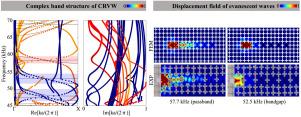Attenuation of Lamb waves in coupled-resonator viscoelastic waveguide
IF 7.1
1区 工程技术
Q1 ENGINEERING, MECHANICAL
International Journal of Mechanical Sciences
Pub Date : 2024-10-19
DOI:10.1016/j.ijmecsci.2024.109790
引用次数: 0
Abstract
Guidance of elastic waves is one of the main applications of artificial crystal structures. The attenuation of the guided waves is, however, often overlooked, as most of the proposed waveguides only comprise ideal elastic materials. In this work, we study the propagation of evanescent Lamb waves guided in coupled-resonator viscoelastic waveguide (CRVW), with special attention to attenuation. CRVW is defined by considering a linear chain of coupled defect cavities in a phononic plate made of epoxy. The viscoelastic behavior of epoxy is characterized numerically by the Kelvin–Voigt (K–V) model. Based on finite element analysis, the complex band structure and the spectrum of frequency response function (FRF) are obtained. Due to viscosity, guided Lamb waves are spatially damped. Two theoretical models are devised to predict the displacement distributions inside and outside a bandgap for guided waves, respectively, considering either the first or the first two least evanescent Bloch waves identified in the complex band structure. A CRVW sample is fabricated and characterized experimentally by laser vibrometry. Evanescent Lamb waves are observed to be strongly confined along the waveguide and at the same time to decay rapidly along the waveguide axis. Experiments and numerical simulations are found to be in fair agreement. The present work is expected to inspire practical applications of highly confined viscoelastic phononic waveguides.

耦合谐振器粘弹性波导中的兰姆波衰减
引导弹性波是人工晶体结构的主要应用之一。然而,引导波的衰减往往被忽视,因为大多数提出的波导仅由理想弹性材料组成。在这项工作中,我们研究了在耦合谐振器粘弹性波导(CRVW)中引导的蒸发兰姆波的传播,并特别关注衰减问题。CRVW 的定义是考虑环氧树脂声波板中的线性耦合缺陷空腔链。环氧树脂的粘弹性行为通过开尔文-伏依格特(K-V)模型进行数值表征。在有限元分析的基础上,得到了复带结构和频响函数(FRF)频谱。由于粘度的存在,导波 Lamb 波在空间上受到阻尼。考虑到复带结构中识别出的第一个或前两个最小蒸发布洛赫波,设计了两个理论模型来分别预测导波在带隙内部和外部的位移分布。我们制作了一个 CRVW 样品,并通过激光测振仪对其进行了实验表征。我们观察到疏散的 Lamb 波沿着波导被强烈限制,同时沿着波导轴快速衰减。实验和数值模拟结果相当吻合。本研究有望激发高约束粘弹性声波波导的实际应用。
本文章由计算机程序翻译,如有差异,请以英文原文为准。
求助全文
约1分钟内获得全文
求助全文
来源期刊

International Journal of Mechanical Sciences
工程技术-工程:机械
CiteScore
12.80
自引率
17.80%
发文量
769
审稿时长
19 days
期刊介绍:
The International Journal of Mechanical Sciences (IJMS) serves as a global platform for the publication and dissemination of original research that contributes to a deeper scientific understanding of the fundamental disciplines within mechanical, civil, and material engineering.
The primary focus of IJMS is to showcase innovative and ground-breaking work that utilizes analytical and computational modeling techniques, such as Finite Element Method (FEM), Boundary Element Method (BEM), and mesh-free methods, among others. These modeling methods are applied to diverse fields including rigid-body mechanics (e.g., dynamics, vibration, stability), structural mechanics, metal forming, advanced materials (e.g., metals, composites, cellular, smart) behavior and applications, impact mechanics, strain localization, and other nonlinear effects (e.g., large deflections, plasticity, fracture).
Additionally, IJMS covers the realms of fluid mechanics (both external and internal flows), tribology, thermodynamics, and materials processing. These subjects collectively form the core of the journal's content.
In summary, IJMS provides a prestigious platform for researchers to present their original contributions, shedding light on analytical and computational modeling methods in various areas of mechanical engineering, as well as exploring the behavior and application of advanced materials, fluid mechanics, thermodynamics, and materials processing.
 求助内容:
求助内容: 应助结果提醒方式:
应助结果提醒方式:


